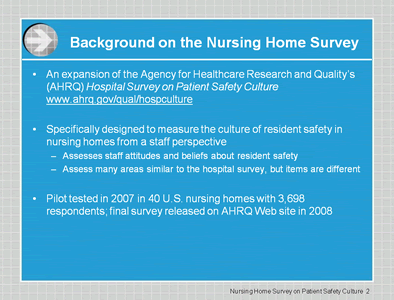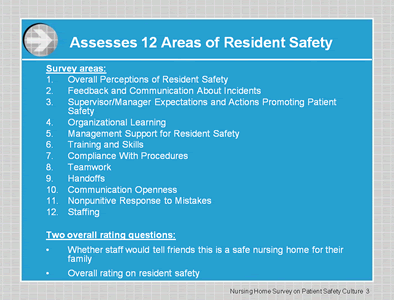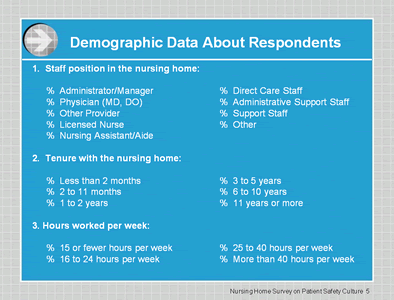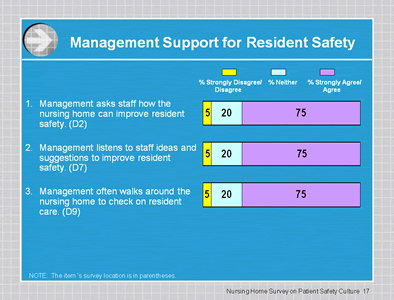Feedback Results
Text Version of a Slide Presentation
Slide 1

{Site Name}
{City, State}
{Date}
For further information about this feedback report, contact:
Name:
Title:
Address:
Phone:
E-mail:
Slide 2

Background on the Nursing Home Survey
- An expansion of the Agency for Healthcare Research and Quality's (AHRQ) Hospital Survey on Patient Safety Culture http://www.ahrq.gov/qual/hospculture.
- Specifically designed to measure the culture of resident safety in nursing homes from a staff perspective:
- Assesses staff attitudes and beliefs about resident safety.
- Assess many areas similar to the hospital survey, but items are different.
- Pilot tested in 2007 in 40 U.S. nursing homes with 3,698 respondents; final survey released on AHRQ Web site in 2008.
Slide 3
Assesses 12 Areas of Resident Safety

Survey areas:
- Overall Perceptions of Resident Safety
- Feedback and Communication About Incidents
- Supervisor/Manager Expectations and Actions Promoting Patient Safety
- Organizational Learning
- Management Support for Resident Safety
- Training and Skills
- Compliance With Procedures
- Teamwork
- Handoffs
- Communication Openness
- Nonpunitive Response to Mistakes
- Staffing
Two overall rating questions:
- Whether staff would tell friends this is a safe nursing home for their family.
- Overall rating on resident safety.
Slide 4

Survey Data Collection
[Describe your nursing home's data collection methods here:]
- When survey was administered & how.
- To whom the survey was administered (if not a census, how was the sample selected?)
- Response rate.
Slide 5

Demographic Data About Respondents
1. Staff position in the nursing home:
___ % Administrator/Manager
___ % Physician (MD, DO)
___ % Other Provider
___ % Licensed Nurse
___ % Nursing Assistant/Aide
___ % Direct Care Staff
___ % Administrative Support Staff
___ % Support Staff
___ % Other
2. Tenure with the nursing home:
___ % Less than 2 months
___ % 2 to 11 months
___ % 1 to 2 years
___ % 3 to 5 years
___ % 6 to 10 years
___ % 11 years or more
3. Hours worked per week:
___ % 15 or fewer hours per week
___ % 16 to 24 hours per week
___ % 25 to 40 hours per week
___ % More than 40 hours per week
Slide 6

Demographic Data About Respondents (continued)
4. Time of shift:
___ % Days
___ % Evenings
___ % Nights
5. Paid by a staffing agency: ___ % Yes ___ % No
6. Direct contact with residents: ___ % Yes ___ % No
7. Work area or unit in the nursing home:
___ % Many different areas or units in this nursing home/No specific area or unit
___ % Alzheimer's/Dementia unit
___ % Rehab unit
___ % Skilled nursing unit
___ % Other area or unit
Slide 7

Main Findings: Strengths
A number of strengths emerged from the results:
- Most respondents...
- Respondents...
Slide 8

Main Findings: Areas for Improvement
A number of areas for improvement emerged from the results:
- Most respondents...
- Respondents...
Slide 9
Nursing Home Recommendation
I would tell friends that this is a safe nursing home for their family

Bar chart displays percentage of respondents responding Yes: 75%, Maybe: 5%, or No: 20%.
Slide 10
Overall Rating on Resident Safety
Give this nursing home an overall rating on resident safety

Bar chart displays percentage of respondents providing an overall rating of Excellent: 60%, Very Good: 20%, Good: 10%, Fair: 5%, and Poor: 5%.
Slide 11

Interpreting the Results
- Positively and negatively worded items are used in the survey.
- A positive response to an item is when respondents answer:
- "Strongly Agree/Agree" or "Always/Most of the time" with a positively worded item.
- "Strongly Disagree/Disagree" or "Never/Rarely" with a negatively worded item.
Slide 12

Interpreting the Results (continued)
Example of Positive Responses on Compliance With Procedures:
| Survey Items |
% Strongly Disagree/
Disagree |
% Neither |
% Strongly Agree/
Agree |
| 1. Staff follow standard procedures to care for residents. (A4) |
10 |
10 |
80 |
| R2. Staff use shortcuts to get their work done faster. (A6) |
80 |
10 |
10 |
| R3.To make work easier, staff often ignore procedures. (A14) |
80 |
10 |
10 |
R This item is negatively worded so disagreeing is "positive".
Slide 13

Overall Perceptions of Resident Safety
| Survey Items |
% Strongly Disagree/
Disagree |
% Neither |
% Strongly Agree/
Agree |
| 1. Residents are well cared for in this nursing home. (D1) |
10 |
15 |
75 |
| 2. This nursing home does a good job keeping residents safe. (D6) |
10 |
15 |
75 |
| 3. This nursing home is a safe place for residents. (D8) |
10 |
15 |
75 |
Note: The item's survey location is in parentheses.
Slide 14

Feedback and Communication About Incidents
| Survey Items |
% Never/
Rarely |
%
Sometimes |
% Most of the Time/Always |
| 1. When staff report something that could harm a resident, someone takes care of it. (B4) |
5 |
20 |
75 |
| 2. In this nursing home, we talk about ways to keep incidents from happening again. (B4) |
5 |
20 |
75 |
| 3. Staff tell someone if they see something that might harm a resident. (B6) |
5 |
20 |
75 |
| 4. In this nursing home, we discuss ways to keep residents safe from harm. (B8) |
5 |
20 |
75 |
Note: The item's survey location is in parentheses.
Slide 15

Supervisor Expectations and Actions Promoting Resident Safety
| Survey Items |
% Strongly Disagree/
Disagree |
% Neither |
% Strongly Agree/
Agree |
| 1. My supervisor listens to staff ideas and suggestions about resident safety. (C1) |
5 |
20 |
75 |
| 2. My supervisor says a good word to staff who follow the right procedures. (C2) |
5 |
20 |
75 |
| 3. My supervisor pays attention to resident safety problems in this nursing home. (C3) |
5 |
20 |
75 |
Note: The item's survey location is in parentheses.
Slide 16

Organizational Learning
| Survey Items |
% Strongly Disagree/
Disagree |
% Neither |
% Strongly Agree/
Agree |
| R1. This nursing home lets the same mistakes happen again and again. (D3) |
75 |
5 |
20 |
| 2. It is easy to make changes to improve resident safety in this nursing home. (D4) |
20 |
5 |
75 |
| 3. This nursing home is always doing things to improve resident safety. (D5) |
20 |
5 |
75 |
| 4. When this nursing home makes changes to improve resident safety, it checks to see if the changes worked. (D10) |
20 |
5 |
75 |
R Indicates a negatively worded item.
Note: The item's survey location is in parentheses.
Slide 17

Management Support for Resident Safety
| Survey Items |
% Strongly Disagree/
Disagree |
% Neither |
% Strongly Agree/
Agree |
| 1. Management asks staff how the nursing home can improve resident safety. (D2) |
5 |
20 |
75 |
| 2. Management listens to staff ideas and suggestions to improve resident safety. (D7) |
5 |
20 |
75 |
| 3. Management often walks around the nursing home to check on resident care. (D9) |
5 |
20 |
75 |
Note: The item's survey location is in parentheses.
Slide 18

Training and Skills
| Survey Items |
% Strongly Disagree/
Disagree |
% Neither |
% Strongly Agree/
Agree |
| 1. Staff get the training they need in this nursing home. (A7) |
20 |
5 |
75 |
| 2. Staff have enough training on how to handle difficult residents. (A11) |
20 |
5 |
75 |
| 3. Staff understand the training they get in this nursing home. (A13) |
20 |
5 |
75 |
Note: The item's survey location is in parentheses.
Slide 19

Compliance with Procedures
| Survey Items |
% Strongly Disagree/
Disagree |
% Neither |
% Strongly Agree/
Agree |
| 1. Staff follow standard procedures to care for residents. (A4) |
20 |
5 |
75 |
| R2. Staff use shortcuts to get their work done faster. (A6) |
75 |
5 |
20 |
| R3. To make work easier, staff often ignore procedures. (A14) |
75 |
5 |
20 |
R Indicates a negatively worded item.
Note: The item's survey location is in parentheses.
Slide 20

Teamwork
| Survey Items |
% Strongly Disagree/
Disagree |
% Neither |
% Strongly Agree/
Agree |
| 1. Staff in this nursing home treat each other with respect. (A1) |
20 |
5 |
75 |
| 2. Staff support one another in this nursing home. (A2) |
20 |
5 |
75 |
| 3 Staff feel like they are part of a team. (A5) |
20 |
5 |
75 |
| 4. When someone gets really busy in this nursing home, other staff help out. (A9) |
20 |
5 |
75 |
Note: The item's survey location is in parentheses.
Slide 21

Handoffs
| Survey Items |
% Never/
Rarely |
%
Sometimes |
% Most of the Time/Always |
| 1. Staff are told what they need to know before taking care of a resident for the first time. (B1) |
5 |
20 |
75 |
| 2. Staff are told right away when there is a change in a resident's care plan. (B2) |
5 |
20 |
75 |
| 3. We have all the information we need when residents are transferred from the hospital. (B3) |
5 |
20 |
75 |
| 4. Staff are given all the information they need to care for residents. (B10) |
5 |
20 |
75 |
Note: The item's survey location is in parentheses.
Slide 22

Communication Openness
| Survey Items |
% Never/
Rarely |
%
Sometimes |
% Most of the Time/Always |
| 1. Staff ideas and suggestions are valued in this nursing home. (B7) |
5 |
20 |
75 |
| R2. Staff opinions are ignored in this nursing home. (B9) |
75 |
20 |
5 |
| 3. It is easy for staff to speak up about problems in this nursing home. (B11) |
5 |
20 |
75 |
R Indicates a negatively worded item.
Note: The item's survey location is in parentheses.
Slide 23

Nonpunitive Response to Mistakes
| Survey Items |
% Strongly Disagree/
Disagree |
% Neither |
% Strongly Agree/
Agree |
| R1. Staff are blamed when a resident is harmed. (A10) |
75 |
20 |
5 |
| R2. Staff are afraid to report their mistakes. (A12) |
75 |
20 |
5 |
| 3. Staff are treated fairly when they make mistakes. (A15) |
5 |
20 |
75 |
| 4. Staff feel safe reporting their mistakes. (A18) |
5 |
20 |
75 |
R Indicates a negatively worded item.
Note: The item's survey location is in parentheses.
Slide 24

Staffing
| Survey Items |
% Strongly Disagree/
Disagree |
% Neither |
% Strongly Agree/
Agree |
| 1. We have enough staff to handle the workload. (A3) |
5 |
20 |
75 |
| R2. Staff have to hurry because they have too much work to do. (A8) |
75 |
20 |
5 |
| 3. Residents' needs are met during shift changes. (A16) |
5 |
20 |
75 |
| R4. It is hard to keep residents safe here because so many staff quit their jobs. (A17) |
75 |
20 |
5 |
R Indicates a negatively worded item.
Note: The item's survey location is in parentheses.
Slide 25

Comparison With 40 Pilot Study Nursing Homes
| Patient Safety Culture Area |
[Site name]
% Positive |
NH Pilot Study Comparison:
Average % Positive |
| 1. Overall Perceptions of Resident Safety |
[Your data] |
87 |
| 2. Feedback and Communication About Incidents |
[Your data] |
85 |
| 3. Supervisor/Manager Expectations and Actions Promoting Patient Safety |
[Your data] |
81 |
| 4. Organizational Learning |
[Your data] |
76 |
| 5. Management Support for Resident Safety |
[Your data] |
72 |
| 6. Training and Skills |
[Your data] |
72 |
| 7. Compliance With Procedures |
[Your data] |
67 |
| 8. Teamwork |
[Your data] |
67 |
| 9. Handoffs |
[Your data] |
63 |
| 10. Communication Openness |
[Your data] |
58 |
| 11. Nonpunitive Response to Mistakes |
[Your data] |
55 |
| 12. Staffing |
[Your data] |
48 |
Current as of March 2009
Internet Citation:
Nursing Home Survey Feedback Report Template. Text Version of a Slide Presentation. March 2009. Agency for Healthcare Research and Quality, Rockville, MD. http://www.ahrq.gov/qual/nhsurvey08/nhsopstxt.htm


